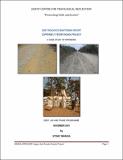Debt Resource Monitoring Report
Date
2010-11Author
Mwansa, Sydney
Type
Case StudyLanguage
enItem Usage Stats
42
views
views
11
downloads
downloads
Abstract
Good road infrastructure is cardinal in the promotion of viable economic activities. This is even more so for the agriculture sector which relies on the road network for transportation of agricultural inputs such as seed and fertilizer and produce to the markets. With the high incidence of poverty (78%) in rural areas, agriculture essentially holds the greatest potential to significantly reduce poverty. Good road infrastructure and network promotes efficiency and increased performance of the agriculture sector which in turn leads to increased production and income generation by the farmers. This also leads to increased food security not only for the household in rural areas but the nation at large
Description
Good road infrastructure is cardinal in the promotion of viable economic activities. This is even more so for the agriculture sector which relies on the road network for transportation of agricultural inputs such as seed and fertilizer and produce to the markets. With the high incidence of poverty (78%) in rural areas, agriculture essentially holds the greatest potential to significantly reduce poverty. Good road infrastructure and network promotes efficiency and increased performance of the agriculture sector which in turn leads to increased production and income generation by the farmers. This also leads to increased food security not only for the household in rural areas but the nation at large.
Improved agriculture performance and efficiency also helps in diversifying the economy from reliance on copper and cushions the economy from external shocks arising from the collapse of metal prices on the world market. Equally important is the fact that agriculture driven economic growth is more sustainable and equitable.
To address the road infrastructure challenges faced by the agriculture sector on the Copperbelt province, the Government of the republic of Zambia contracted a loan amounting to US$ 14 million from the Arab Bank for Economic Development in Africa (BADEA) and the Opec Fund for International Development (OFID) for the rehabilitation of forty feeder roads on the Copperbelt. BADEA provided US$8 million while OFID provided US$6 million. The project was to be co-funded by the Government of the Republic of Zambia (GRZ) which would contribute US$1 million. At the time of signing, the project was supposed to be executed by the Road Development Agency (RDA) within a period of three years.
